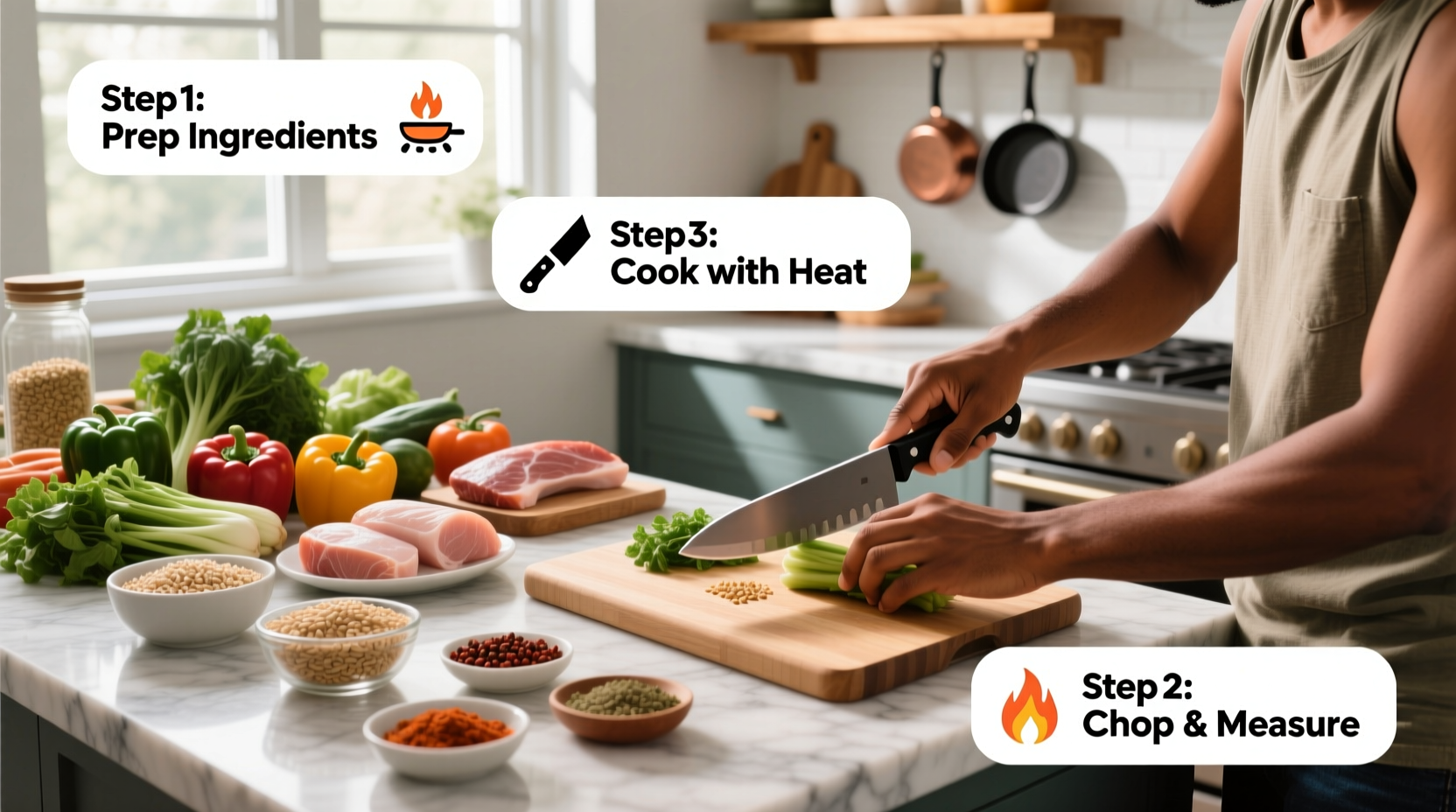Your Beginner's Roadmap to Making Food Successfully
Learning how to make food doesn't require expensive equipment or years of experience. As a culinary professional who's taught thousands of beginners, I've found that success comes from understanding a few core principles rather than memorizing complex recipes. The journey from "I can't cook" to "I made this!" typically follows a predictable path that takes most beginners just 3-6 months to master.
First Month Cooking Progression
- Week 1-2: Master scrambled eggs and toast - learning heat control and timing
- Week 3-4: Prepare simple one-pot meals like pasta with jarred sauce
- Month 2: Experiment with basic seasoning and cooking proteins like chicken breasts
- Month 3: Create balanced meals with homemade components
Essential Kitchen Setup for Beginners
Forget those "must-have" kitchen gadget lists. Professional chefs consistently recommend starting with just five tools that handle 90% of cooking tasks:
| Essential Tool | Beginner Alternative | Professional Tip |
|---|---|---|
| 8-inch chef's knife | Multi-purpose utility knife | Keep it sharp - a sharp knife is safer and more effective |
| 12-inch skillet | Non-stick frying pan | Stainless steel provides better browning but requires practice |
| Wooden spoon | Heat-resistant silicone spoon | Won't scratch pans and handles high heat |
| Measuring cups/spoons | Standard kitchen spoons and cups | Weight measurements yield more consistent results |
| Colander | Metal strainer | Essential for draining and rinsing ingredients |
Master These Three Fundamental Cooking Methods
According to the USDA Food Safety and Inspection Service, proper cooking techniques prevent foodborne illness while maximizing flavor. Focus on these three methods first:
Sautéing: Your Most Versatile Technique
This dry-heat method works for vegetables, proteins, and more. The key is understanding the visual cues:
- Oil behavior: When oil shimmers but doesn't smoke, it's ready
- Protein doneness: Chicken should reach 165°F internally (use a thermometer)
- Vegetable texture: Should be tender-crisp, not mushy
Boiling and Simmering: More Than Just Pasta
The difference between boiling (bubbles breaking surface) and simmering (gentle bubbles) determines whether your food becomes tough or tender. For example:
- Eggs: Simmer gently to prevent cracking
- Stocks: Simmer slowly for clearer, more flavorful results
- Pasta: Boil vigorously to prevent sticking
Roasting: Hands-Off Flavor Development
Rather than baking (which typically refers to breads and pastries), roasting transforms vegetables and proteins through dry heat. The Maillard reaction—the chemical process that creates complex flavors—begins at 285°F. For perfect results:
- Dry ingredients thoroughly before roasting
- Don't overcrowd the pan (creates steam instead of browning)
- Flip halfway through cooking for even browning

Three Starter Recipes to Build Confidence
These recipes follow the progression recommended by culinary schools for beginners. Each builds on skills from the previous one:
1. Perfect Scrambled Eggs (First Attempt)
Why it works: Teaches heat control and timing with immediate feedback. The USDA recommends cooking eggs until both whites and yolks are firm to prevent foodborne illness.
2. One-Pan Chicken and Vegetables (First Week)
Why it works: Introduces protein cooking with visual doneness cues. Proper internal temperature (165°F for chicken) is critical for safety according to FDA guidelines.
3. Simple Pasta with Homemade Sauce (First Month)
Why it works: Combines multiple techniques while demonstrating how fresh ingredients improve flavor. The American Dietetic Association notes that homemade sauces typically contain less sodium than store-bought versions.
Troubleshooting Common Beginner Mistakes
Every cook makes these errors. Here's how to fix them:
Burnt Food
Why it happens: Heat too high or leaving food unattended
Solution: Start with medium heat, especially with stainless steel pans. The Culinary Institute of America recommends the "water droplet test"—water should dance but not instantly evaporate.
Bland Flavors
Why it happens: Not seasoning in layers or using stale spices
Solution: Season at multiple stages. As professional chefs note, "If you're tasting for salt at the end, you've already missed opportunities to build flavor."
Overcooked Vegetables
Why it happens: Continuing to cook after removing from heat (carryover cooking)
Solution: Remove vegetables from heat when they're slightly underdone—they'll continue cooking off-heat.
Practical Tips for Consistent Success
Based on research from the Journal of Culinary Science & Technology, these evidence-based practices improve beginner cooking outcomes:
- Prep everything first (mise en place): Reduces stress and prevents burning
- Taste as you go: Adjust seasoning incrementally rather than all at once
- Start with quality ingredients: Fresh garlic always beats jarred, even for beginners
- Keep a cooking journal: Note what worked and what didn't for each attempt
When to Break the Rules
While food safety guidelines are non-negotiable, some "rules" can be adapted based on your cooking context:
| Traditional Rule | When to Follow | When to Adapt |
|---|---|---|
| Never wash chicken | When preparing for others (salmonella risk) | Personal cooking with immediate cooking (reduces splatter) |
| Always use exact measurements | Baking (chemical reactions) | Sautéing vegetables (taste preferences vary) |
| Rest meat after cooking | Larger cuts (roasts, whole chicken) | Small portions (chicken breasts, fish fillets) |
Your Cooking Journey Starts Now
Remember that every chef was once a beginner. The most important step is simply starting. Choose one technique to practice this week, and remember that even "failed" attempts teach valuable lessons about heat, timing, and flavor development. As you gain experience, you'll develop intuition that goes beyond recipes—truly understanding how to make food that satisfies both your palate and nutritional needs.











 浙公网安备
33010002000092号
浙公网安备
33010002000092号 浙B2-20120091-4
浙B2-20120091-4